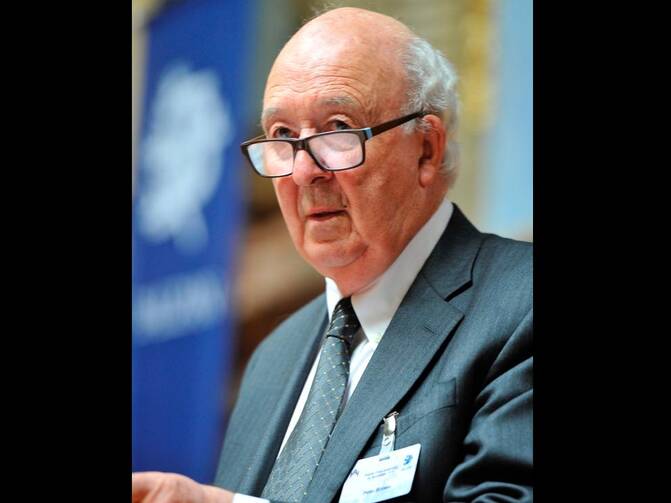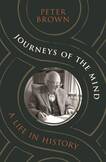Review: Peter Brown’s memoir details a life of joyful scholarship
The historian Peter Brown is 88 years old, and judging from his new 700-page memoir, he has lost none of the energy or curiosity that has marked his distinguished career. Journeys of the Mind is an impressively detailed account of his intellectual odyssey from Ireland to his years of study and teaching at Oxford to academic posts in London, Berkeley and, finally, Princeton.
Brown is perhaps most well-known for his classic biography of St. Augustine of Hippo. That book was published in 1967, and his career has ranged far and wide since, taking him from holy men of Syria to the cult of the saints in Europe to a study of sexual renunciation in early Christianity. His memoir traces each of these developments in his thinking, grounding them in humor and personal anecdotes. His writing style is accessible and charming, the mark of an academic who spent much of his career writing for the educated public.
That he was a religious minority and hailed from a family of middle-class but learned people—would inform Peter Brown's scholarship and writing all through his career.
He begins with the story of his ancestors and the larger story of Protestants in Ireland. From a young age, Brown was well aware that he was part of a religious minority, though one with a distinguished pedigree. William Butler Yeats was the cousin of a cousin, and his “mother’s mother” had connections with the family of the playwright and poet John Millington Synge. It was a culture that took books and ideas seriously: “Most of these people were of limited means. They did not own many books—but they read what they had.”
Both of those facts—that he was a religious minority and that he hailed from a family of middle-class but learned people—would inform his scholarship and writing all through his career.
It was a sacrifice for Brown’s family to send him to the Shrewsbury School in England, where he had to contend with the peculiarities of the English class system. But Brown thrived, and he offers winning anecdotes of the old dons who taught him. From “the Duke,” a history teacher named Murray Senior who reminded students of the Duke of Wellington, he first heard the voice of what he calls “grown-up history”: “Suspicious of generalizations; demanding facts and figures; and notably averse to ‘vast and vague’ talk about ideas: the Duke’s comments have always been for me the beginning of wisdom.”
When he went to Oxford to take its entrance exam, he began to see history firsthand, since much of the school had not changed since the 15th century. It sent his mind whirring. But could his parents afford to send him? The question hangs in the air until he wins a prize fellowship at All Souls College, given to the two most promising students. (The other winner: the Canadian philosopher Charles Taylor.)
There are many threads in Brown’s story. A fan of St. Augustine may wish to read about how the seeds for that biography were first planted. Another reader may be riveted by his trips to Iran for research in the years just before the 1979 revolution. An academic may find it intriguing to witness his journey from the tutor-based educational system at Oxford to the graduate school training we are more familiar with in the United States.
Rarely have I encountered a more compelling case for the physical act of reading—or what he calls “tenacious Sitzfleisch.”
One thread that I relished tracing was the importance of reading in Brown’s life. Rarely have I encountered a more compelling case for the physical act of reading—or what he calls “tenacious Sitzfleisch.” He writes about the hours spent reading while sitting next to the stove in his parents’ kitchen in Ireland. He shares the thrill of perusing the shelves of the Library of Classical Studies at the Ashmolean Museum in Oxford: “I would approach those shelves like a water-diviner, hoping against hope to touch some fresh new spring in the daunting array of new publications.” This was in 1958, long before the days of digital indexing. Indeed, it was several years before the photocopier was in wide use. Mining for ideas was hard work.
It is also enjoyable to simply take in the personalities Brown meets along the way. One formidable character is the anthropologist Mary Douglas, who shared with him an early copy of her seminal book Natural Symbols. Douglas helped Brown to see the relationship between religion and society in a new light. Along with E. E. Evans-Pritchard, another formative influence, Douglas refused to look down on religious practice and ritual and took issue with the Catholic Church, for example, for relaxing the rules regarding eating meat on Friday.
At the Oxford Patristics Conference in September 1963, Brown encountered priests and religious who took part in the Second Vatican Council, including Cardinal Jean Daniélou, S.J. The historians at the conference were thrilled by the idea of ressourcement and how it might invigorate their own studies of the ancient world. For Brown, that meant the period of late antiquity, when the Roman Empire gave way to the rise of Christianity. His observations about that moment in history have a timeless relevance: “It was by reaching out beyond itself, and not walling itself off, that Christianity had come to dominate the Roman world.”
This book really is about the life of the mind, an intellectual journey formed by deep reading and extensive travel and nourished by relationships and conversation.
Later in the book, after moving across the world to U.C. Berkeley, Brown enjoys long conversations at the “Bear’s Lair” with Michel Foucault. His encounters with Foucault offer an example of the “journeys of the mind” that he is so interested in exploring. In 1980—perhaps because “sexual emancipation…was in the air”—Brown decided to begin studying different understandings of sex during late antiquity. It was then that he began reading Foucault, who pushed back against the overly simplified narrative of the time, which saw the sexual revolution as the end of a period of repression that had lasted for centuries.
Quoting Foucault, Brown writes that “sexuality had become ‘the noisiest of our preoccupations. People will wonder what could make us so presumptuous.’” Brown’s goal was to help people understand a culture very different from their own, and reading Foucault helped him to see the influence of modern prejudices.
There are many such heady moments in Brown’s tome, and the reader may be forgiven for taking time with the text. (His narrative ends in 1987, with a brief postscript on his work “Since Then.”) The chapters are short and engaging but packed with ideas. Reading a chapter or two at a time allows the material to sink in. “I would like the reader to follow (and at a leisurely pace) the development within me of a historical sense,” Brown writes in his introduction. Leisurely is the right word, and readers used to a different kind of memoir—one with more gossip and less Latin—may find the terrain hard going.
Indeed, there is not much here on Brown’s personal or spiritual life, though he does mention that after traveling to Iran and watching Muslims at worship, he returned to attending services in his own Christian church after many years away. This book really is about the life of the mind, an intellectual journey formed by deep reading and extensive travel and nourished by relationships and conversation, from the dining rooms of Oxford to Peet’s Coffee in Berkeley.
A reviewer is tempted to conclude with some reflections on the state of intellectual discourse today, to wonder perhaps whether our digital, distracted world can produce another Peter Brown. But such ruminations are not in keeping with the spirit of this book, which has little time for hand-wringing. Journeys of the Mind presents a very attractive picture of one man’s life immersed in the world of books and arguments—one that, to this reader at least, seems like a lot of fun. Perhaps that is all that needs to be said.
This article also appeared in print, under the headline “A Mind at Work,” in the December 2023, issue.











